A couple days ago I got a comment on my post “Bird by Bird, Part 3B,” which raised a very interesting question. In the variation that runs 1. e4 e5 2. Nf3 Nc6 3. Bb5 Nd4 4. Nxd4 ed 5. O-O g6 6. d3 Bg7 7. f4 c6 8. Ba4 d5 9. ed Qxd5 10. Re1+ Ne7 11. Bb3 the only move I discussed in my blog post was 11. … Qd8. Even though this move was played by none less than Boris Spassky, I expressed my feeling of uneasiness about the continuation 12. f5! (not played by Spassky’s opponent) Bxf5 13. Bg5! f6 14. Bf4.
In his comment, James Burke asked a very natural question:
Due to the Bg5 pin on the queen – apart from that of the rook on the king – the obvious thought that occurred to me was, “Why place the queen on a square to be pinned?†(rather like the proverbial idea of “castling into itâ€).
The obvious move is 11…, Qd6.
and then he goes on to give some of his own and Rybka’s analysis of this line. So let’s take a look at the position after 11. … Qd6:
First of all, let me say that I would really like this to work for Black, because it would simplify my approach to the 7. f4 line. I would like to give a blanket recommendation that Black should always play … c6 and … d5. Unfortunately, this line with 8. Ba4 seems to be the one stubborn holdout, and I had to come reluctantly to the conclusion that 8. … d6 is safer in this one case.
The reason I originally thought 11. … Qd6 was bad was that White simply plays 12. Qe2! Now in the 11. … Qd8 variation, the recipe against 12. Qe2 is 12. … Bf6 followed by 13. … O-O. But here there is an inconvenient problem: after 12. … Bf6? White plays 13. Nd2, and after 13. … O-O? 14. Ne4 forks the queen and bishop and wins material. That is why Black had to bring his queen all the way back to d8.
But Burke and Rybka show that things are not so simple for White. After 12. Qe2 they recommend 12. … h5! This is pretty amazing — here Black’s king is still in the center, with a rook and queen staring him in the face, but Black just blithely ignores that and plays a non-developing move on the kingside. The point, though, is that Black wants to play … Bg4 and chase White’s queen away from the e-file, after which Black will be able to castle and have a decent game.
Now actually White may do well just to continue his development and allow this: 13. Nd2 Bg4 14. Qf2 O-O 15. Ne4 Qd7 16. Nc5 Qc7 17. f5! gives White the same sort of active piece play that we were trying to avoid. Fritz gives this a +/=, and this is already enough reason to look with some suspicion on 11. … Qd6. However, Rybka and Fritz both agree that the main line is 13. h3, where White tries to prevent Black from untangling his pieces. This brings us to the position shown below.
Diagram 2 (after 13. h3).
So the question is: Has Black gained anything from the interpolation of … h5 and h3?
Rather surprisingly, the answer is yes! This morning I thought I found a beautiful equalizing line for Black. Here it is: 13. … Bf6!? (the move we couldn’t play before) 14. Nd2 (the move that seemed to refute … Bf6 before) 14. … Bf5!
Diagram 3 (after 14. … Bf5!)
Now it seems as if this move couldn’t possibly be playable, because White can simply chase the bishop away with 15. g4? However, if White plays this, Black can draw by force! The idea is 15. … hg 16. hg Qxf4! Okay, now we start to see how the interposition of … h5 and h3 changed the position in Black’s favor — because White’s king is now vastly more exposed. But still, it seems as if 17. Ne4! is deadly. Black can’t take on g4 because White will take the bishop on f6 with check and a fork. Meanwhile, what is Black going to do about his queen, which is under attack by White’s bishop?
The answer is — sacrifice it! Black plays 17. … Bxe4!! 18. Bxf4 Rh1+ 19. Kf2 Bh4+! 20. Bg3 Rh2+ with a draw by repetition!
White’s king can’t escape from the checks on h2 and h1. Black has to settle for the draw, too, because he has too many pieces en prise to successfully take White’s queen.
What a sensational line! I was thinking now that James’s 11. …. Qd6, with that incredibly subtle followup, was starting to look pretty good. Unfortunately, Fritz threw some cold water on my idea. If we go back to Diagram 3, we can see that 15. g4 was a mistake, and White should play in simple, cold-blooded positional fashion with 15. Ne4. Now 15. … Bxe4 16. de is forced. It’s not as if I missed this — after all, the whole idea of 14. … Bf5 was to take the knight if it came to e4 — but Fritz shows how dominating White’s position is. I will skip the detailed analysis, but basically the point is that Black is going to lose two more tempi moving his queen and bishop out of the way of the pawn fork. And even so, the move e4-e5 for White is going to cut off the defense of the d4 pawn, and also create some dangerous possibilities of e5-e6 at some point. It is unlikely that Black will actually be able to hang on to his d4 pawn, but even if he does, all the ingredients in the position favor White — the two bishops, the open lines, the mobile pawn majority on the kingside. So once again, romantic tactical dreams get shot down by cold, hard positional facts.
That means we have to go back to Diagram 2 to look for improvements for Black, and in fact there is one: both computer programs recommend 13. … Be6! Black gives up a pawn with 14. Bxe6 Qxe6 15. Qxe6 fe 16. Rxe6 Kd7 17. Re4 Nf5.
What do you all think about this position? I’d be interested to hear other opinions. Fritz calls it about equal. If 18. Nd2 the tactical line 18. … Ne3 19. Nb3 Nxc2 etc. seems to work out okay for Black. Otherwise, for example if 18. Bd2, Black’s idea is to clamp down on the kingside with 18. … h4 and make it impossible for White to activate his pawn majority.
However, I’ll tell you why I don’t quite trust this position for Black. The thing is that I don’t see anywhere on the board where Black can actually create threats. So basically, Black’s lead in development has reached its zenith, and Black is going to just sit there trying to keep his finger in the dike, while White will gradually get his pieces out and eventually start thinking about a break in the center. Maybe I’m too pessimistic, but I don’t see any winning chances for Black, only drawing and losing chances.
So, all in all, James’s suggestion of 11. … Qd6 was a really nice try, which had more to it than met the eye, but I’m still not happy with Black’s position. My recommendation remains unchanged — either avoid this whole mess and play 8. … d6, or else play Spassky’s 11. … Qd8 and keep your fingers crossed.
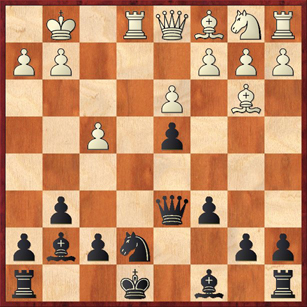
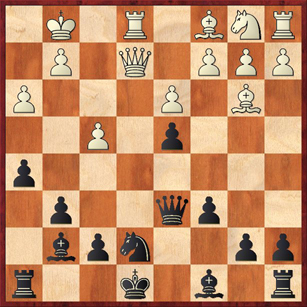
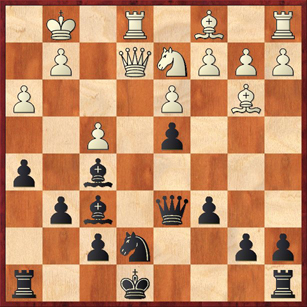
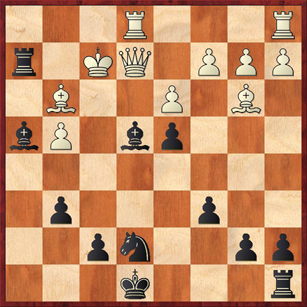
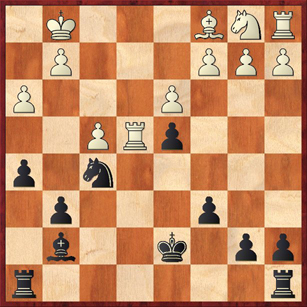



{ 8 comments… read them below or add one }
Greetings,
Dare I say you’re too pessimistic!?* ;D
[Ironic this: my discussing a line in a opening I don’t play…! When I first started playing chess (1970’s) I tried the Open games – as recommended to beginners – and booked-up on the Marshall – but then found that no-one allowed it, so I gave up 1…, e5 and switched to 1…, c5. I’ve played the Sicilian ever since – but it would be nice to be able to play the Open games, as black. (I’m a d-pawn player as white – the American(!) boy who taught me, asked why I played 1.d4 – I told him “Because it’s protected by the queen”. I’m a “calculated risk” man – I’m Irish, by the way.) Emms’ excellent “How To Play The Open Games As Black” takes care of all other openings – it’s just the Ruy Lopez that needs a suitable line, preferably something which takes the white Ruy Lopez player out of his comfort zone…]
Just a quick point…
In your last diagram, 18…, Ne3 only works against 18.Nd2 (as I’m sure you know) – it doesn’t work against 18.Bd2. In the latter case, 18…, Ne3?; 19.Bxe3, de; 20.Rxe3??, loses the rook to 20…,Bd5 [21.Kf2, R(either)e8]. But White, of course, has 20.Re1, Bxb2; 21.Nc4, Bc3; 22. R1xe3.
So, neither of those eighteenth moves you mentioned work for White. A better way to prevent the loss of the c-pawn – not to mention the rook in the corner(!) – would be 18.Na3.
* “However, I’ll tell you why I don’t quite trust this position for Black. The thing is that I don’t see anywhere on the board where Black can actually create threats. So basically, Black’s lead in development has reached its zenith, and Black is going to just sit there trying to keep his finger in the dike, while White will gradually get his pieces out and eventually start thinking about a break in the center. Maybe I’m too pessimistic, but I don’t see any winning chances for Black, only drawing and losing chances.”
This is the reason for my (cheeky!?) comment at the start of this reply!
As we all know, a lead in development has to be used immediately – such as through an attack – to keep the opponent from having the time to complete his/her development.
From the strategic perspective, in the above position, I’d be looking to get control of the only open file, to invade White’s position, by playing Re8 – which one depends on the resulting variations.
But it’s more likely that attacking weaknesses – such as the f-pawn – will keep the initiative.
There’s also the possibility of 18…, Ng3/d6 – attacking the rook – to keep White “on the ropes”, as it were, so that he can’t develop his queen-side.
In this case, the only move is 19. Re1, when 19…,Re8 challenges for the file.
For example, 18. Na3, Ng3; 19. Re1, Re8; 20. Bd2, Re2? is apparently embarrassing, as the bishop can’t go anywhere:
21. Ba5, b6; 22. Bb4, c5; or 21. Bb4, a5 (note that this can only be played if the rook is still on a8 – so, it may be better to play 19…, Rhe8)
So 21. Rxe2, Nxe2+ is virtually forced (unless White wants to play the passive 21. Rad1, R(other)e8) 22. Kf2, Re8; 23. Re1 and now it’s the knight who is embarrassed.
So, 20…, Re2? is not the best!
Looking at it again, it seems to me that a plan involving piling up on the white f-pawn with …, Rhf8 and …, g5 – and …, b5 (to keep the knight on the rim) – would be more useful in keeping White on the back foot.
18.Na3, Ng3; 19.Re1, Rhf8; 20.Bd2, b5; 21.Kf2, h4; 22.Kf3, g5; 23.Kg4, gf regaining the sacrificed pawn.
If, for instance, 24.Rab1, which Rybka seems to prefer, 24…, Rg8; and my silicon pet suddenly doesn’t like White’s position(!) – it switched from +0.14 to -0.3.
“Well, you wanted to play Rab1!”
For example, 25.Kf3, Raf8; and I think Black is looking better – there are threats against the g-pawn (…,Nf5-e3) as well as the check (with …,Rg3+). Rybka gives this -0.11.
With the above in mind, better is 25…,Bf8 (with the idea of switching to d6 – which is assessed as -0.15); 26.Ra1, Bd6; 27.Rg1, Nf5 (-0.62!)
I don’t know what you make of this – not to mention your own pet, Fritz!
There is also either 18…, Nd6 or 18…, R(either)e8.
I’m not sure about the merits of either of these – like yourself, I don’t there’s forceful enough play for Black to keep the initiative.
But I think the “keep White on the back foot” plan with …,Rhf8; …,b5 – as above – works.
I’ll look forward to your thoughts!
Kindest regards,
James
Greetings,
I didn’t mention it in my last – I thought it didn’t need to be said – but, perhaps, I shouldn’t leave you to do all the “reading between the lines” analysis…
In the last option involving 25…, Bf8, the f-pawn is “poisoned”.
Obviously 26. Kxf4??, leads not only to the loss of the bishop on d2 by 26…, Bh6+ – but is mate in one – 26…, Bd6.
Nor is 26. Bxf4? any better as it opens lines to the king. 26…, Bb4; 27.Re5, Bd6; 28.Rg5, Raf8; 29.Rg4, Rxg4; 30.Kxg4, Rxf4+ and Black is to be preferred, I think!
In all the above variations, from both posts, it’s clear that the knight on g3 is doing sterling work taking away critical squares from White – f1, e2 and e4 – as well as cramping White’s king-side pawns, supported by 18…, h4 as you’d mentioned in response to 18. Bd2[This is why 18…, Ng3 is to be preferred to the other attack on the rook with 18…, Nd6.]
In variations involving …,Ng3-f5-e3 – where Black now has his pawn on f4 – the fact that White can’t capture it by Bxd3 due to that resulting in a protected passed pawn for Black is another reason why it’s important for Black to target/capture the f-pawn – not just to regain material equality.
If the knight does arrive back on e3, with the added protection of the f-pawn, White’s g-pawn (and g3 square) are obvious targets for attack/ingress to White’s position. With doubled-rooks and the knight attacking it, the g-pawn will fall due to the lack of defenders which White can muster – the king and one rook (Black’s f-pawn would be protected by the bishop on d6).
I trust that this shows that Black does have some weaknesses in White’s position of which to take advantage.
Kindest regards,
James
Greetings,
This is a sample of what I’ve been analysing:
1.e4 e5 2.Nf3 Nc6 3.Bb5 Nd4 4.Nxd4 exd4 5.O-O g6 6.d3 Bg7 7.f4 c6 8.Ba4 d5
9.exd5 Qxd5 10.Re1+ Ne7 11.Bb3 Qd6 12.Qe2 h5 13.h3 Be6 14.Bxe6 Qxe6 15.
Qxe6 fxe6 16.Rxe6 Kd7 17.Re4 Nf5 18.Na3 Ng3 19.Re1 Rhf8 20.Bd2 b5 21.Kf2
h4 22.Kf3 g5 23.Kg4 gxf4 24.Rab1 Rg8 25.Kf3
(25.Kxh4?? Bf6# is another “poisoned-pawn” one-mover!)
25…, Bf8 26.Re5 Bd6 27.Ree1
(For some reason Rybka wanted to play 27.Rae1 here!? I wasn’t having that…)
27…,Nf5 28.Rg1 Ne3
(28…,Rg3+ is a option here (-1.64) 29 Ke2 – not 29 Ke4?? Ne3 30.b4 c5 31.Bxe3 Re8+ 32.Kf5 (32.Kd5 Re5#) Rf8+ 33.Ke4 Rxe3+ 34.Kd5 Re5# – 29…, Re8+ 30.Kf2 Ne3 31.Rc1 Reg8 and the g-pawn falls (-1.68) )
29.Be1 Be7 30.Bf2 Rae8 31.Rbe1 Bf6 32.Re2 Rg7 33.Nb1 Reg8 34.c3 Rxg2 35.Rxg2 Rxg2 36.cxd4 Bxd4 37.Bxe3 Rxe2 38.Bxd4 Rh2 39.Kxf4 Rxh3 40.Nd2 a5 41.a3 Rh1 42.Ne4 Ke6 43.Ng5+ Kd5 44.Bb6 a4 45.Kg4 Rh2 46.d4 Rxb2 47.Bc5 b4 48.Bxb4 Rxb4 49.Nf3 h3 50.axb4 a3.
On 50.Kxh3 then Rb3 51.Kg4 Rxa3 wins easily.
That’s just a line I examined – I’m sure there’s better to be found, but it does show some of the potential of what I was mentioning.
Kindest regards,
James
Greetings,
Just a correction…
In my second post above, I said:
“Obviously 26. Kxf4??, leads not only to the loss of the bishop on d2 by 26…, Bh6+ – but is mate in one – 26…, Bd6.”
This is slightly premature!
26. Kxf4?? Bd6+ 27. Kf3 Raf8 28.Bf4 Rxf4# is correct.
One other point…
In all this I never thought to check any databases to see if the 11…,Qd6 move/line(s) have occurred before!
I only have a small database which doesn’t show anything other than a Jenni-Spassky game, which didn’t feature this move.
I’d be interested to hear if you know any better.
Kindest regards,
James
Do ever examine the line 1. e4 e5 2.Nf3 Nc6 3. Bb5 Nd4 4.Nxd4 exd4 5. 0-0 or any other reasonable move followed by Bc5 and black ideas of d6 followed by b5 with intent to lock down the center and to attack the kingside? I have had pretty good results in blitz and internet play with these ideas
Thanks for the insight – I really enjoyed this blog. After reading and re-reading I don’t see where the ‘Center variation’ is covered. When white plays 5 d3 or 5 0-0 followed by d3. How would you proceed in that case?
Hi David,
Thanks for your question. Actually in the above analysis White did play 5. O-O followed by 6. d3 in some of the games. The real dividing line is what happens on the seventh move. Parts 3A and 3B discuss 7. f4 and show, I think, that Black is doing fine. Part 4 is what I think you’re asking about, where White plays 7. c3. The link to that post is http://www.danamackenzie.com/blog/?p=425.
Interestingly, I recently played a tournament game against a player (Theodore Biyiasis) who had read my “Bird by Bird” posts and was thus completely ready for the Bird. This was a first for me. Theodore had the idea of playing NEITHER 7. f4 NOR 7. c3 (i.e., not really trying to refute Black’s setup) but just continuing his methodical development with 7. Nd2, Nf3, etc. I think this is a very pragmatic approach that cannot be bad for White. I’m not sure if I reacted the right way. The game went 7. Nd3 c6 8. Bc4 d5. As we’ve seen, this “urgent” approach is necessary for Black if White challenges him with 7. f4 or 7. c3, but if White is going to take a more “laid-back” approach with 7. Nd2, 8. Nf3 etc. then perhaps Black should also be more laid-back with 7. … Ne7 and 8. … O-O. Obviously this line needs more exploration.
Hi Dana,
Thanks for the response. I am enjoying playing this response to the Ruy Lopez. Did you ever do the write-up for ‘part 5’ referred to as the ‘bashful bishop’ ?